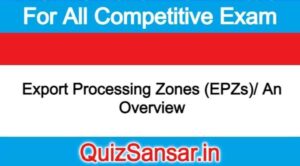
Export Processing Zones (EPZs)/ An Overview
Export Processing Zones (EPZs) are specific geographic locations, physical sites, business premises, buildings and/or assigned localities that have special tax, tariff, or investment incentives and customs (duty) regimes in order to promote export-oriented industry and transactions. Traditionally, EPZs include locations that house special economic zones, free trade zones, free ports, custom zones, commercial free zones, and bonded facilities/ warehouses. Not exclusively limited to a specified geographic area or fenced. enclave, EPZs can also include single-company, single-industry, or single commodity zones, as well as technology/science parks, logistics centers, specific areas dedicated to agriculture, aquaculture, and horticulture, and, in some instances, even tourist resorts and passenger transport vessels. EPZs were originally established with the intention of supporting developing countries by providing enhanced employment opportunities and increased
access to foreign capital. EPZS initially segregated the concentration of expertise in the higher economically developed countries to the more technical/scientific areas, while the less economically developed countries focused on more labor-intensive areas. EPZS are often found in jurisdictions where there are geographic or logistic advantages, or where production inputs are comparatively inexpensive-such as labor, raw materials, energy, or physical space-and/or where tax or tariff incentives and existing regulatory environment are favorable for investment. Activities that can take place within EPZs include he manufacture of goods and services, production, processing, assembling, adding, repair, recondition 2, reengineering, and/or packaging/re-packing/ labeling of export products or services.
EPZs usually offer infrastructure of a higher standard than that available in a respective domestic economy. Electronics, textiles, clothing, and footwear were the popular industries initially established in EPZs; however, the product and service mix today can include almost any sector and can transform over time as a respective country’s economic, industrial, and social development changes. With the increase in traded services export and the proliferation of technical and scientific expertise export, EPZs around the world are counting in greater numbers zones concentrating on biotechnology, financial services, information technology, and information/ electronic data processing.
An EPZ, depending upon the country, legislative environment, existing free trade agreements, and relevant jurisdictions, can be established by the public, private, joint sector, or by local, state, or national governments. Initially established by governments, there is a growing trend toward the development of EPZS by private organizations, which tend to offer higher quality facilities. Firms located in EPZs can usually access, procure, or import duty-free goods from external sources, or from other EPZs, as long as the final product or service is exported. Incentives are provided for the purpose of the eventual export of a good or service. Incentives vary country to country and zone to zone, but can range from tax holidays, duty-free export and import, staff training and employment subsidies, and free repatriation of profits to the provision of facilities, infrastructure, and exemptions from local labor laws. To qualify for incentives, there are normally criteria imposed such as level of investment, industry or industry sector, local content inputs, or levels of local employment.
EPZS are generally viewed today as a competitive method to attract both foreign investment and increase local employment opportunities. In Asia, cities like Hong Kong and Singapore have established themselves as both regional export gateways as well as significant global transshipment centers through the provision of special customs regimes for export processing and transshipment.
In North America, one particular permutation of the EPZ has been seen on the Mexican side of the U.S.-Mexico border, where maquiladoras have emerged as a convenient method for North American firms to access the comparatively cheaper labor and energy costs of neighboring Mexico. A maquiladora or maquila is a production facility, normally bonded premises, that imports materials and equipment on a duty-free and tariff free basis for either manufacturing or final assembly, and then re-exports the finished or assembled product. A maquiladora facility is often matched by a “twin” production plant or logistics center across the border.
The history of EPZs goes back to the earliest days of cross-border trade, where special areas were often set aside for the barter and exchange of goods, and were often regulated by customs, practices, rules, and laws that were separate from the surrounding area. In more modern times, the establishment of the first export oriented zone occurred in Spain in 1929. However, it was not until the 1970s that the EPZ concept gained true global popularity with zones established, initially, in the developing economic regions and nations of Asia, Latin America, the Caribbean, and Africa. Since the 1970s, the number and type of EPZs, and the number of hosting countries, have expanded rapidly, and are becoming increasingly popular in former Soviet bloc countries in eastern and central Europe.
EPZs can be viewed as a positive or negative outcome of globalization. On one side of the argument, the development of EPZs can be seen as a way to attract foreign investment, increase exports, support comparatively rapid economic development, and enhance a country’s strategic trading role. On the negative side, EPZs can be perceived as exclusive sites and sources of human, resource, and environmental exploitation that offer limited direct benefit to a country or its people.






